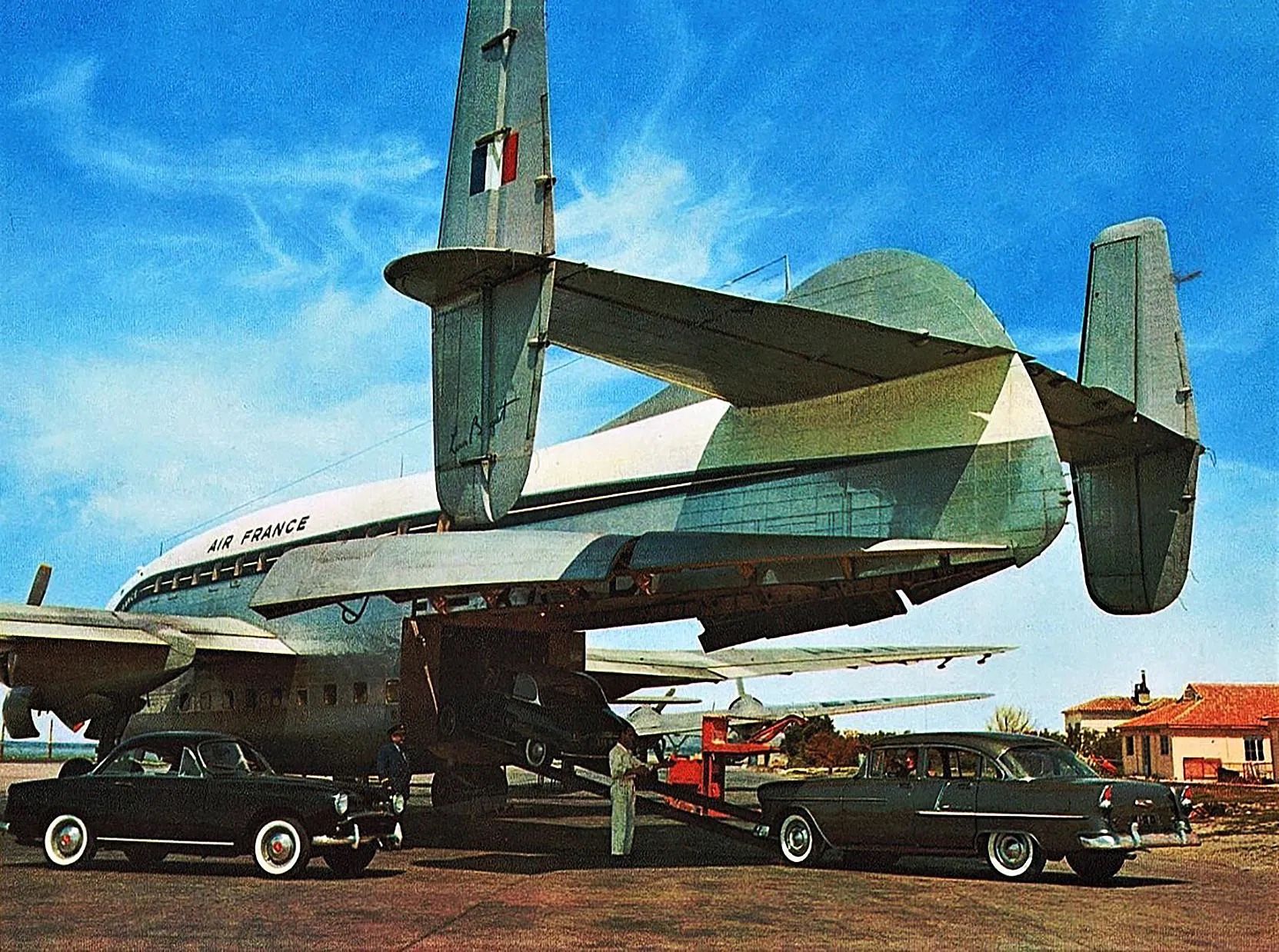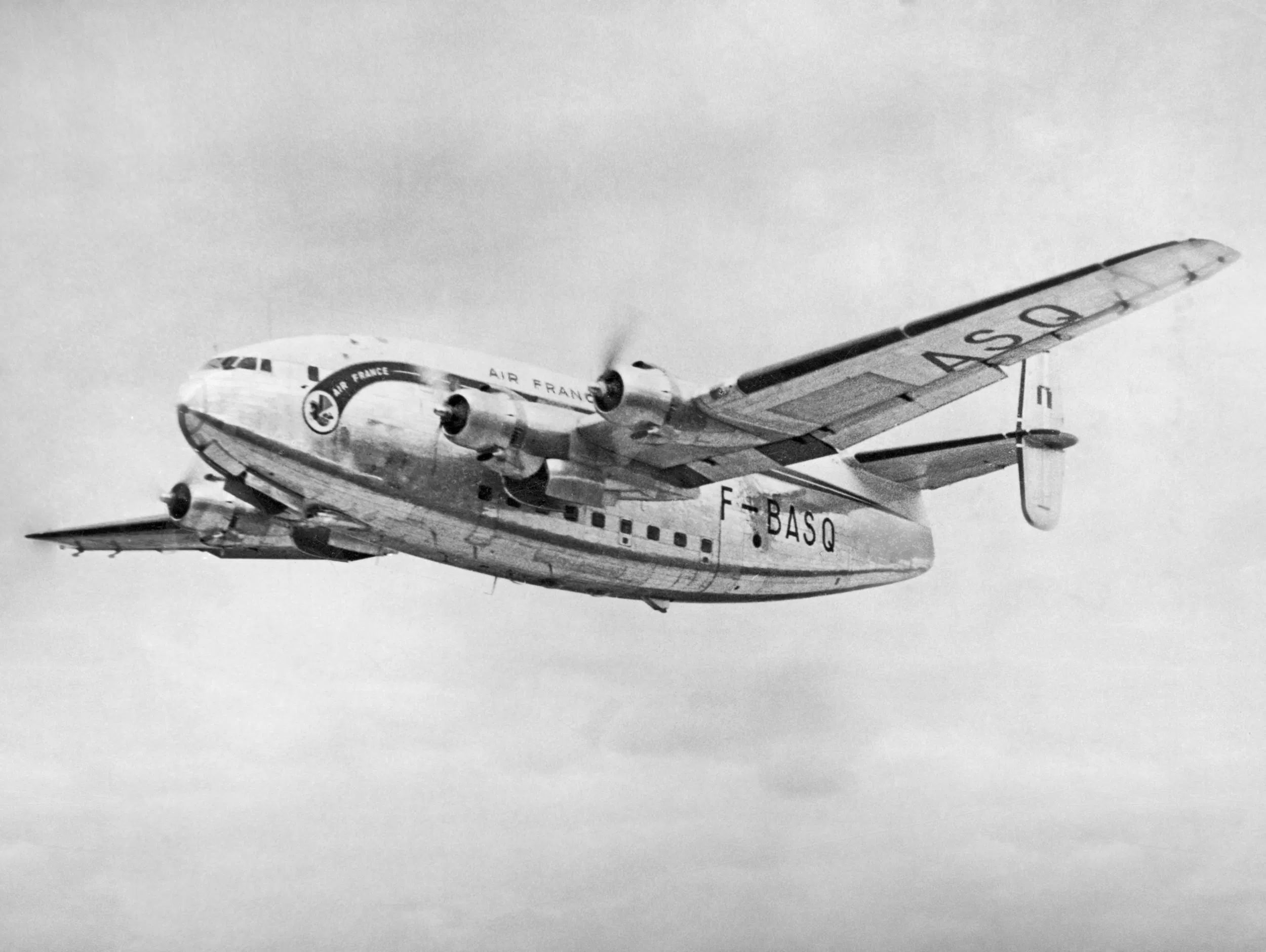The Bréguet 763 ‘Deux-Ponts’, French for “Two Decks,” was developed in France and entered service in the early 1950s. The aircraft proved helpful in serving the French Air Force and as a transport plane. The 763 also established an impeccable safety reputation for its time, without a passenger or crew injury or fatality.
The aircraft derived its name, Deux-Ponts, from its double-decker cabin design with four engines and two cabin floors. The first of its kind. At one point, it was the largest airliner in the world. It was configured to carry around 107 passengers, accommodating 59 on the upper deck and 48 on the lower deck.
The history of the Bréguet 763
At the end of WWII, Germany’s invasion of France halted Bréguet’s production of its new aircraft.
- In 1944, Bréguet designed a 100-seat airliner to help restart the French airline industry after the war.
- Five years later, the prototype took its first flight.
- In 1951, the 763 took its first flight, and subsequent test flights progressed well with no incidents. Bréguet informed potential buyers that the 763 was intended for both passenger and cargo transport.
-
In 1953, the Bréguet 763 entered service with
Air France.
In 1951, the French government ordered 12 Bréguet 763s. Six units were given to Air France, helping boost the country’s airline industry, and the French Ministry of Aviation used the other six for military transport.
The aircraft proved to be very safe, with no serious incidents. However, it did not sell well abroad, as jet airliners became increasingly popular. By the mid-1960s, the Bréguet 763 Deux Ponts was also outdated in France due to its competition with newer jets and turboprops.
The design of the Bréguet 763
The Deux-Ponts had a cantilever wing at mid-height on the fuselage and was fitted with retractable tricycle landing gear with dual-wheel central units.
The flight deck was designed for a crew of four: two pilots, one flight engineer on the left, and one navigator on the right behind the pilots. The navigator had a table and radio gear next to him. If there were only three crew members, the second pilot could move back to the navigator’s spot by folding up the table. The large windows allowed the crew to look out to check on the engines easily.
Bréguet highlighted the aircraft’s versatility. It could carry either 44 passengers on the upper deck, 12 in the front lower cabin, and 20 in the rear lower cabin, or be arranged with 32 sleeping berths. When the aircraft was stationary, crew and passengers could use an elevator to move between the two floors.
The Deux-Ponts in the French Air Force
The French Air Ministry awarded Bréguet a contract to build a single prototype with a 2,000km range and the ability to carry bulky cargo. Louis-Charles Bréguet saw the ‘double-decker’ configuration as quite versatile.
“I can’t be certain to have to carry homogenous loads on each flight,” he said. “Maybe I will have to carry coal and flowers, and I can’t imagine mixing such disparate loads. That’s why I’ve designed an aircraft with two loading levels: a double-decker aircraft.”
The aircraft could transport cows, sheep, up to 120 paratroopers, 120 stretchers for medical missions, military vehicles, or serve as a flying workshop for military support. In 1969, it was eventually replaced by the turboprop Transall C-160, built by a French-German consortium.
Photo: JEAN-CHRISTOPHE CARBONEL
Air France and the Bréguet 763
The Bréguet 763’s versatile design features made it famous among passengers and Air France from a business standpoint, and it operated the aircraft from 1953 until 1971. The propliner served medium-range destinations and flew primarily between Paris and Algiers. On occasion, the Deux-Ponts were also used on cross-channel flights to London and domestic routes within France from Paris to the regions.
In 1958, in hopes of improving sales, Bréguet leased back a 763 unit from Air France and took it on a tour within North and Latin America. The aircraft covered an impressive 25,000 miles, stopping in New York, Washington, DC, and Miami in the United States before flying down to Bogotá in Colombia, Santiago in Chile, and Rio de Janeiro in Brazil. However, the introduction of the jet-powered Caravelle
made the 763 obsolete. Some aircraft were transferred to the French Air Force, and the rest were used as freighters until they were withdrawn from service in 1971.
Photo: KEY COLLECTION
Louis-Charles Bréguet’s influence on aviation
Louis-Charles Bréguet, born January 2, 1880, was a French airplane builder. Many of his planes set world records. In 1919, he established a commercial air transportation company, Compagnie Des Messageries Avienne, which now operates worldwide under the name Air France.
- Bréguet built his first airplane in 1909 and set a speed record for a flight of 10 kilometers in 1911.
- In 1912, he constructed his first hydroplane, and in 1917, he designed and flew a “gyroplane,” the forerunner of the helicopter.
- During World War I, he manufactured military planes; his Bréguet-XIX was especially noteworthy.
- In 1927, a Bréguet plane made the first nonstop crossing of the South Atlantic.
- In 1933, another Bréguet plane made a 4,500-mile flight across the Atlantic, the longest nonstop Atlantic flight at the time.
During World War II, Bréguet remained an important manufacturer of military planes and produced a series of large four-engined transports afterward.
The Bréguet 763 in summary
The Bréguet 763 ‘Deux-Ponts’ was a pioneering double-decker aircraft developed in France and introduced in the early 1950s. It served the French Air Force and commercial sectors with an impeccable safety record. Born out of the post-WWII era, its design aimed to revive the French airline industry and led to its service with Air France and a significant stint with the military.
Despite its innovation, changing aviation needs led to its phase-out by 1971. The aircraft’s legacy is also tied to Louis-Charles Bréguet, the founder of Air France, who contributed significantly to early 20th-century aircraft design and technology.



